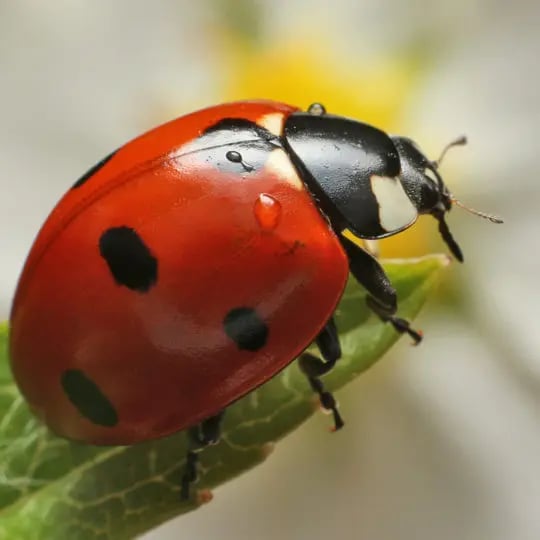Lawn Pest Library
Asian Lady Beetle (Ladybug)

Scientific Name: Harmonia axyridis
Lifespan: One to two years
Brief description: Asian lady beetles, often called ladybugs in the United States or ladybirds in Britain, are known for their spots and cheerful colors. In general, they are a useful insect because they love to eat aphids and can help farmers control aphid populations. However, they can become pests when they crawl through windows and cracks into homes to overwinter inside. They also can emit a noxious, staining yellow substance from their legs when they feel threatened.
What are Asian Lady Beetles?
The Asian lady beetle is a brightly colored beetle with anywhere from zero to 22 spots. They go through four stages, just like any insect. The beetles eggs resemble tiny yellow jellybeans. In its larval stage, the beetle resembles a tiny black and yellow alligator. In its pupal stage, it looks more like a yellowish-orange shrimp. And in its mature adult form, the beetle is bright red, orange or yellow, with any number of black spots.
According to legend, lady beetles got their name from Catholic farmers back in the Middle Ages, when insects were destroying the crops. The farmers prayed to the Virgin Mary for help. Soon these spotted little beetles arrived, devoured the plant-destroying pests and rescued the crops. The insects began to be known as “The Beetles of Our Lady”, then ultimately became known as “Lady Beetles.” The red wings represented the Virgin’s cloak and the black spots represented her joys and sorrows.
Asian lady beetles are common in wooded areas, fields, and home gardens. Their favorite food is aphids, but they also eat other soft-bodied insects. When aphids become scarce, lady beetles will fly to other food sources, such as fall-ripening apples and other fruit plants. They only consume apples that already have openings made by birds and other insects.
Signs and Symptoms of Asian Lady Beetles
Asian lady beetles are yellow, orange or scarlet red in color, with black spots on their wings, and black head, legs and antennae. Adults are about oval in shape and about ¼ inch long. Eggs are yellow, oval, and laid in clusters on the underside of leaves. Larva are yellow and black and shaped like miniature alligators.
Beetles tend to infest buildings in the fall, as they prepare to overwinter. Swarms of these bugs may be visible on windows, doors, wall crevices, and inside attics from September through November, depending on location and weather conditions. They do not cause any serious harm, and they do not reproduce indoors. However, they can emit an unpleasant odor and a yellowish staining fluid when disturbed. Asian lady beetle infestations can cause allergies in some people.
How to Prevent Asian Lady Beetles
Asian lady beetles are usually not a problem in gardens, unless aphids are unavailable and they begin to eat fruit. If you have fall-ripening fruit trees and plants such as apples, grapes or raspberries, pick up fallen fruit and remove damaged fruit. This will help discourage lady beetles from snacking on these plants.
When lady beetles become a nuisance inside, you can manage them in several ways. If you can stand it, just leave them alone. Disturbing them can scare them and cause them to emit that smelly, staining yellowish fluid. Besides, these insects will not eat anything indoors and will leave as soon as the weather warms up. But if you need to get rid of them, the simplest method of removal is probably the vacuum cleaner. Sweeping them out with a broom can work, but it usually causes the bugs to release the staining fluid.
Seal small cracks and openings in walls and around windows and pipes in the spring and early summer, and plug larger holes with cement, foam or copper mesh. Seal gaps under sliding glass doors with foam weather stripping. Repair window and door screens, and install screens behind attic vents, where beetles love to come in. For persistent lady beetle problems, talk to a pest control professional.
Need Help with Asian Lady Beetle (Ladybug)?
Call today at and let's talk about how we can help you with Asian Lady Beetle (Ladybug) and other Lawn Pest Library.